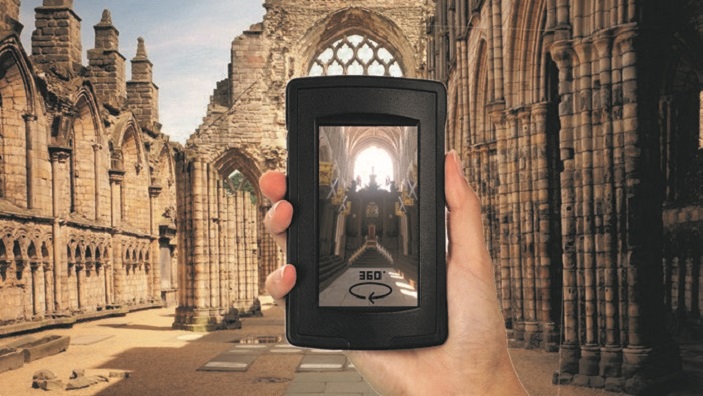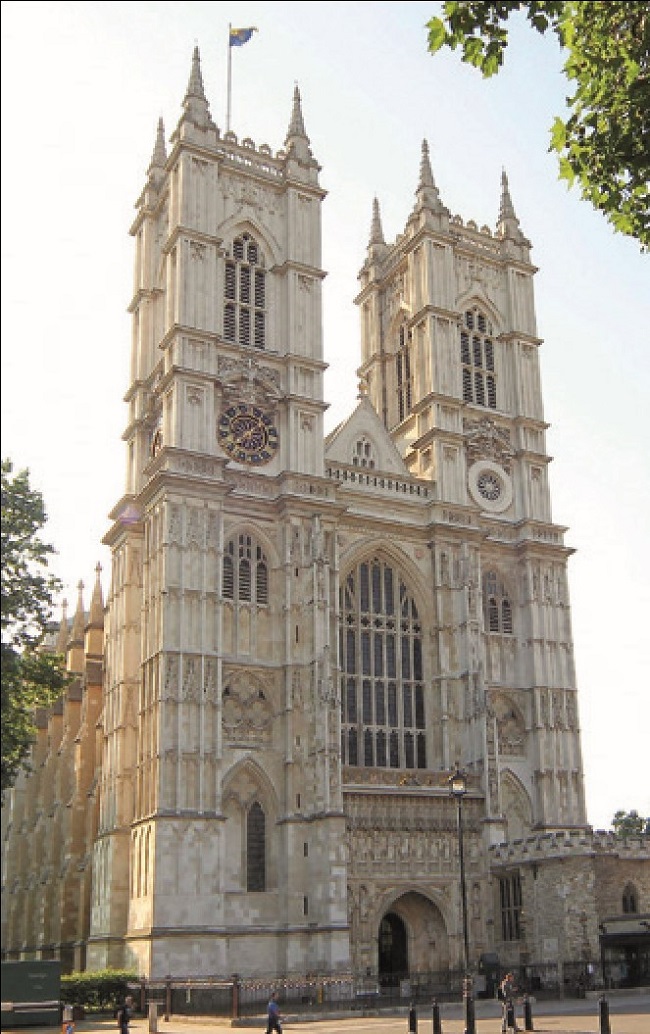Digital Churches
Enhancing the Visitor Experience
Spencer Clark
 |
||
| The implementation of multimedia guides and augmented reality helps visitors to see what a partially ruined structure like Holyrood Abbey (pictured) would have looked like in the past. Visitors are presented with a realistic 3D model of its original construction which they can move through 360 degrees (Photo: all images ATS Heritage) |
Our churches are treasure houses full of monuments, stained glass and carving and all are intricately woven into the fabric of our history and culture. They were all built for the same purpose and yet no two are identical; each church has a unique story to tell.
Volunteers and staff have been the bedrock of church interpretation for years, helping visitors to find their meaning by providing answers to questions, conducting tours and offering general support. This core interpretation is often supported by leaflets and signage, but more churches are now supplementing this traditional strategy with something new. They are going digital. But why?
It seems that today many churches are facing challenges that can’t be addressed using traditional methods alone. The challenges include how to engage and inspire people when there is so much competition for their time; how to tell stories that are relevant, often to people of other faiths or of no faith at all; how to reveal the history written in a church’s fabric when it is unintelligible to the modern eye; how to balance the needs of tourists with the daily round of worship; and how to improve sustainability and attract funding. In terms of funding requirements, the need to resolve these issues has become even more imperative as the likes of the National Lottery Heritage Fund now places the needs of visitors at the heart of every application.
MULTIMEDIA GUIDE
 |
|
| Many tours use a full range of multimedia to appeal to families. Children and their parents can engage with characters and play games on-screen to help them relate to a building’s story. The tour pictured is one of many offered at Westminster Abbey (also pictured). | |
 |
So how can digital technology help? Multimedia guides (which can be accessed using a handheld mobile device) are uniquely placed to meet the challenges outlined above. Their introduction in churches means that visitors now have access to a digitally interactive and userfriendly tool designed to help them form a connection to a church and its history in a modern, engaging and varied way.
The digital content provided can be structured to meet the needs of a number of different audience groups, giving them tailored access to a church building and its stories. Tours can be developed in a range of languages, all of which are accessible on one handset, and for deaf or blind visitors a multimedia guide can deliver sign language translations in the form of high definition videos and specially written audio described tours.
Families are a key target audience for churches but they are often difficult to entice. They look for fun, active and sometimes educational things to do together, particularly during school holidays. To meet these needs, many churches now use digital technology to implement a range of specially designed family tours, with great success. They use the full range of multimedia to offer children and their parents the opportunity to engage with characters from history, take part in spotting competitions and play games on-screen. It’s important to note that the best multimedia guides take storytelling and not technology as their starting point.
When developing digital content for a larger and more varied audience it’s important not to forget those who wish to visit churches for worship. Churches and cathedrals often welcome layered digital content that allows visitors to explore both worship and history, and move freely between the two. This approach makes it easier for a church to fulfil its mission as well as meet visitors’ needs, and has the effect of neutralising any tension between the two. Visitors can pick what they want to see and where they want to go at the pace they choose because all the information they need is in their handset.
Digital content can also help to reveal the day-to-day life of a church, much of which is not visible to visitors. Digital programs can bring it alive with films of services, on-screen glimpses behind the scenes and interviews with clergy and staff about daily worship. Really engaging digital content will encourage visitors to look at what is around them, to talk to those nearby and to come off their own devices. Multimedia guides can encourage visitors to really look at a building by painting a bigger picture and drawing attention to tiny, yet significant details that might otherwise go unnoticed.
The multimedia guides can help lead people around a complicated site or building without difficulty. Developing a comprehensive visitor route is a key part of a tour and designing a linear or free flow journey to maximise exploration, minimise pinch-points and manage dwell times keeps the crowds flowing at a steady rate. This, accompanied with a choice of content for visitors to listen to, watch and interact with helps to facilitate a deeper understanding of a church’s story.
It should be noted that churches and cathedrals were built to create a sense of awe and to touch people spiritually, and this can be lost if there is a clutter of signage, ticket desks and leaflet racks. One of the reasons that digital interpretation is proving popular is because it doesn’t require any installation in public areas. Many churches have actually been able to reduce or remove signage and visitor leaflets following the implementation of multimedia guides and other digital innovations, which are outlined below.
AUGMENTED AND VIRTUAL REALITY
 |
||
| Digital technology may use video, creative storytelling, imagery and other interactive content to encourage visitors to see a church differently and draw attention to important details that might otherwise go unnoticed. | Using the new digital technology, information about the church building and its history can be easily accessed by visitors via their handheld devices. | |
Augmented reality (AR) is a technology that superimposes a computer-generated image over a user’s view of the real world (usually as an app on a smartphone or tablet screen), providing a composite view. The technology has been used in the heritage sector for several years. At Holyrood Abbey visitors can stand in the middle of the part-ruined Abbey and hold up their multimedia guide as a viewport to the past. They are presented with a realistic 3D model of its original construction which they can move through 360 degrees. This technique can also be used on websites or tablet kiosks, allowing visitors to explore a space in 3D and access additional layered content such as audio, text, images or video. The St Mary’s Church in Chalgrove website includes this feature (chalgrovechurch.org).
Another digital innovation that has been used to enhance visitors’ experience is virtual reality (VR). VR allows the user to view, move around and interact with a 3D virtual space, objects and characters by wearing a headset. Although group experiences are being explored with VR, currently this is seen as an individual experience and can be delivered on-site (with equipment provided) or at home (if users have their own equipment).
Virtual reality sound delivers an immersive audio experience in which the user has the freedom to explore buildings and spaces at their leisure. The user wears a set of smart headphones which can precisely locate the direction that they are looking and moving in, and the software is used to design and place virtual speakers throughout a space which the visitor can physically move in and out of, or to and from. Imagine having listened to a welcome by the chaplain as you walk from the font, and an organ beginning to play as you walk down the nave.
Finally, the implementation of projection mapping and light projection technologies can provide a show piece where objects can be lit up, wall paintings can be animated or enhanced and audio music or narration can be included to help bring atmosphere to the spaces and life to the stories they tell.
These are just a few examples of where technology can offer opportunities to enhance storytelling and interpretation in churches. The challenge is to evaluate the solutions carefully to ensure that they meet the overall project objectives. Consideration needs to be made for the demographic of the likely audience, the initial production costs, hardware costs and technical requirements, staffing and operations, and ongoing maintenance and costs.
CASE STUDY 1:
|
CASE STUDY 2:
|



